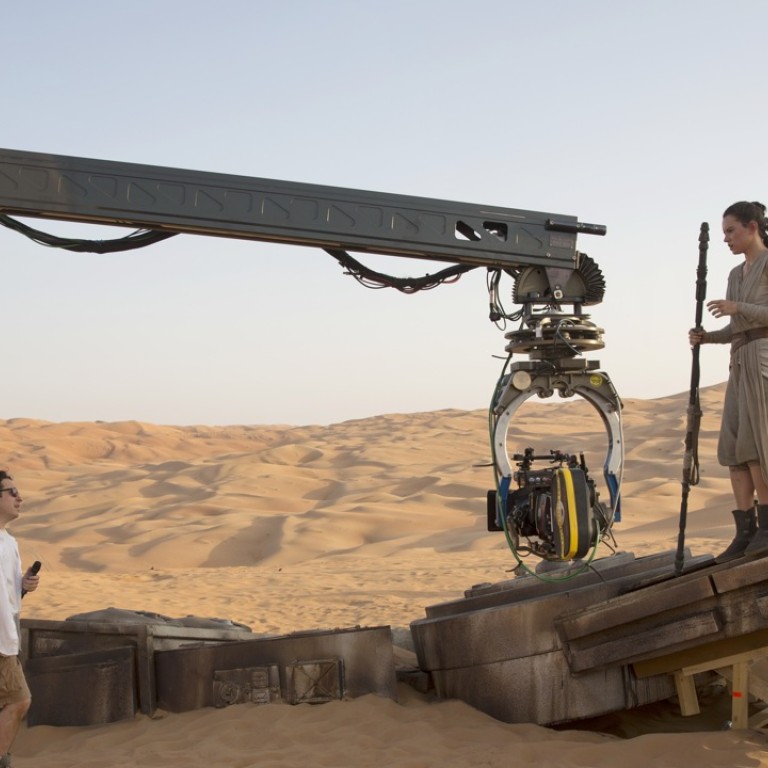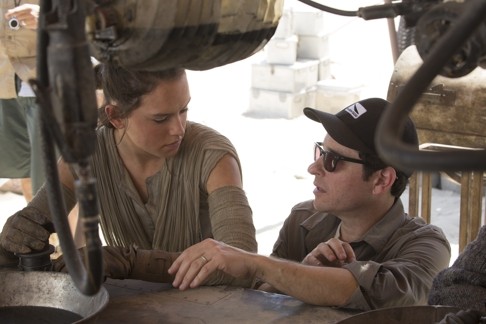
Why J.J. Abrams chose Arabian desert to shoot Star Wars battle scenes
Stunning landscape and financial incentives from the Abu Dhabi Film Commission made the sandy settings of the Empty Quarter ideal for shooting parts of The Force Awakens
Just 2½ hours outside the ultra-modern city of Abu Dhabi, the terrain is so alien you might as well be on another planet. Martian-red sand dunes as tall as skyscrapers roll out as far as the eye can see and a fine copper-coloured dust hangs in the air like low-lying fog.
The Arabian peninsula’s Rub’ al-Khali desert is the stuff of fantasy, which is precisely why Star Wars: The Force Awakens was shot there. In early 2014, director J.J. Abrams and nearly 800 cast and crew trekked into the largely uninhabited region known as the Empty Quarter to build things, film them – and blow them up.
They had plenty of room to stage intergalactic battles. Rub’ al-Khali is the world’s largest contiguous desert, a sea of sand stretching from Oman to Saudi Arabia, the United Arab Emirates (of which Abu Dhabi is the capital) and Yemen.
Presumably lured by the planet Jakku-like landscape – and the 30 per cent cashback rebate the Abu Dhabi government offers to those who shoot in the emirate – the Star Wars crew spent six months filming key scenes on a secret closed set that was said to resemble a small city.
From Abu Dhabi, the Star Wars crew would have been shuttled past the city’s modern high-rises, its suburbs’ pristine Mediterranean mansions, the outskirts’ shabby workers quarters, then desolate salt flats, an occasional goat herder taking refuge under a makeshift tent, and grazing camel herds.
In the company of a guide from the Abu Dhabi film authority, this reporter made a similar three-hour journey by car to the Empty Quarter. A dead, shrivelled camel lying on the side of a sand dune is just one reminder that even the hardiest of creatures is not always a match for the Rub’ al-Khali.
The guide finally stops our vehicle in an area of the desert known as Liwa, adjusting his headscarf before stepping out of the air conditioning and into the heat.

The Star Wars set was off-limits to press and visitors, and those who worked on the film were sworn to secrecy about everything having to do with the production.
“We used the code Avco in everything we did in relation to Star Wars,” says Noura al-Kaabi, CEO of Abu Dhabi’s Media Zone Authority and production facility, twofour54. On her conference wall in Abu Dhabi is a giant mosaic of the emirate’s late ruler Sheikh Zayed al-Nahyan (a common sight in the region), and on the floor below, a life-size C-3PO (not so common). She picked up the latter from a prop store in the UK.
“Even with the government we had to use code when speaking about it,” she says. “When I asked, ‘Why is the code word Avco?’ they said it was the name of the cinema in Los Angeles where J.J. Abrams watched Star Wars for the first time. So sentimental, right?”
According to reports from regional papers, a “whole world” was erected in the desert and it included a “shuttle-like” spacecraft, “fast buggies” powered by jet engines, and giant craters made with explosives.
It was an arduous process scouting the site where, as one film authority representative tells me, battle scenes involving the Millennium Falcon were shot. And once they did settle on a location, there was the question of how to provide access – for example, building roads where none had been before.
“Our contractor said, no, you can’t build here because these are all preserved sands,” Kaabi says. “Luckily the head of the environment agency is a good friend. I said to her, ‘We need to build a road. Whatever we have to do, we will do to get this done. It’s Star Wars.’”
Her friend set up a screening room and persuaded environmental inspectors to watch a screening of the first film in the franchise. “These are men in their late 50s, and many hadn’t seen the films,” Kaabi says. “She said, ‘Look, this is going to be filmed in Abu Dhabi.’ They were not only watching to see what it would look like, but they started commenting, ‘Well, could I be that character?’ They wanted to be part of the set.”
Crews from Bollywood’s film industry accustomed to working in challenging terrain were flown in from nearby India to help build sets. Cast and crew from the US were given detailed packets on how to survive shooting in such brutal, albeit beautiful, surroundings.
“The heat was so – aah, my God – so intense,” says actress Daisy Ridley, who plays the fighter pilot Rey. “Like sweaty and gritty, we were filthy in it.”
Still, she adds, “it was amazing to start on location, everyone was together, everyone was bonding. And we had people making it as easy as physically possible. I think when it was difficult it needed to be. You can’t look like you’re prancing across a track field. Running through sand is really difficult.”

These desert scenes were originally slated to be shot in Jordan, another Arab country that’s a short flight from Abu Dhabi. Paul Baker, executive director of twofour54’s film & TV services and formerly of Hollywood’s Pinewood Studios, had heard Star Wars was looking for a desert backdrop, and contacted producer Tommy Harper.
“I said, ‘I know you may have this other place in mind, but maybe just come here and see what we have to offer’,” Baker says. “He initially passed. Then I got an email sometime later that just said, ‘Let’s talk.’ I will never delete that email,” says Baker, laughing.
Abrams and some of the crew stayed at the Empty Quarter’s Qasr Al Sarab resort, according to hotel workers who broke the code of silence. Situated off a winding road in the middle of towering sand dunes, the resort is also constructed like a set from another place and time, its stone walls, turrets and gurgling fountains an oasis.

But Star Wars might have never gone there were it not for an aggressive push by Abu Dhabi over the last decade to establish the emirate as a media and film hub in the Arab world. Abu Dhabi, one of seven emirates that includes nearby Dubai, is among the wealthiest regions in the world thanks to its oil and natural gas industries. But it is preparing for a not-so-distant future when the oil runs dry.
The film authority is enticing Hollywood productions with healthy rebates to shoot there and a technologically advanced infrastructure (something many neighbouring countries lack). Its more recent successes have been Furious 7, The Bourne Legacy and Deliver Us From Evil. The only requirement is that these productions – including Star Wars – hire a small percentage of local interns so they can receive training on the job. The government has set a goal to have its own fully independent studio system up and running by 2030.
Star Wars’ desert set has since been disassembled, despite rumours that say otherwise. The film authority is still reticent to discuss any details about what exactly was shot in the Empty Quarter, though some of it can clearly be seen in the official trailer for the film.
“I heard rumours they had problems with the Stormtroopers’ boots melting in the desert heat” I say. “It’s one more secret the desert holds,” a film authority representative jokes.
Los Angeles Times
Star Wars: The Force Awakens is in cinemas now

